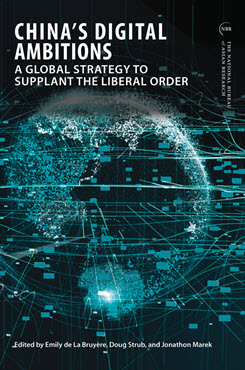A New Type of Geopolitical Power
China’s Competitive Strategy for the Digital Revolution
This is the introduction to the NBR Special Report “China’s Digital Ambitions: A Global Strategy to Supplant the Liberal Order.”
Download the full report in: French | Japanese | Korean.
Download the Executive Brief in: French | Japanese | Korean.
The project also features an interactive data tool for visualizing the global reach of China’s digital ambitions and the relationships between different forms of Chinese digital influence: Access the data tool here.
The Chinese Communist Party (CCP) has diagnosed that the emergence of data as a factor of production is catalyzing a new industrial revolution. Chinese policymakers view this industrial revolution as a competitive opportunity to leapfrog to leadership of the international system. Beijing’s global digital strategy rests on seizing this opportunity by competing to control international data, its movement, and, by extension, the production, distribution, and consumption of resources and ideas internationally.
A new global digital architecture is taking shape. It is both disrupting the existing hierarchy and creating the foundation for a new kind of geopolitical power. China intends to define this digital architecture by building its physical infrastructure and corresponding virtual networks and platforms, setting the technical standards that govern them, and shaping the emerging global digital governance regime. In doing so, it is cementing Chinese control over the international flow of data—and, as a result, resources.
The digital revolution promises a new era of opportunity, technological advancement, and freedom of movement and thought. However, it also entails unprecedented dangers: the possibility of digitally empowered authoritarianism that reaps profits as it asserts control, a monopolistic network power that squeezes out competition in favor of a rent-based system of political and commercial hegemony, and the capacity to shape, alter, and amplify information at a network- effect pace and scale. China’s digital ambitions threaten the ability of companies to compete fairly in the international marketplace, of information to circulate freely, and of governments to defend themselves. China’s success would undermine the existing global system as well as the norms, freedoms, prosperity, and stability that it affords. But China’s success in achieving its digital ambitions is not a foregone conclusion—if, that is, liberal democracies and market economies stand up to Beijing’s challenge. They must work together to promote and defend a digital architecture that can resist illiberal, non-market control and protect the free flow of information. This will be the defining battleground of international relations for the decades ahead.
This report judges that China is strategically and deliberately capitalizing on the digital revolution as an opportunity to define and assert control over international resources, markets, and governance. The six chapters document Beijing’s strategic approach to the digital revolution, its growing global influence, and implications for the international order. The first four chapters map China’s efforts to rewrite the international digital architecture from the ground up, including through the proliferation of digital infrastructure and platforms, as well as from the top down, via influence over technical standards and governance systems. They reveal that China is turning traditionally commercial and cooperative global domains into battlefields of nation-state competition. They also find that Beijing benefits from a set of asymmetric, structural advantages— scale, centralization, and industrial capacity—that may be newly and uniquely determinative for the digital contest, at least as China is engaging in it. Chapter 5 draws on these findings to demonstrate that Beijing’s approach to the digital revolution could transform the nature and stakes of geopolitical power—with corresponding direct security risks, as well as broader commercial, political, and normative ones. However, Beijing’s agenda is not a fait accompli. A set of multilateral proactive and defensive actions laid out in the final chapter aim to provide a roadmap for an effective, and feasible, response.
DEFINING THE DIGITAL REVOLUTION
The idea of a new industrial revolution is not unique to China. Germany has its Industrie 4.0 national strategic initiative, venture capital firm Andreessen Horowitz has made “software eating the world” buzzworthy, and the World Economic Forum operates a Center for the Fourth Industrial Revolution. However, China’s framing of today’s industrial revolution is unique, particularly in terms of the perceived implications for international competition.
Chinese policy and strategic discourse assesses that industrial revolutions come about as a result of new factors of production. Today’s industrial revolution, the digital revolution, is a function of data having emerged—alongside land, labor, capital, and technology—as a factor of production. A 2020 article in Qiushi explains that “production factors are an ever-evolving historical category. Land and labor were important production factors in the era of the agricultural economy,” but “after the industrial revolution, capital became an important factor of production in the era of industrial economy.” The article continues: “With the advent of the digital economy, data elements have become the new engine for economic development. Data is a new production factor, a basic resource, and a strategic resource.”[1]
Beijing frames the resultant global transformation in geopolitical terms as a competitive opportunity to reshape the international hierarchy.[2] Nation-state interaction is defined by a contest for resources. The incumbent leader is powerful because it has an advantage over the legacy basket of resources. But when a new factor of production emerges, that structural advantage fades, and the playing field evens. Rising powers are presented with the opportunity to challenge the hierarchy—not just grow within it. In fact, they have an advantage: unburdened by the inertia and responsibilities that weigh down the incumbent power, they are both more likely and more able to compete in the ways necessary to take advantage of new trends. A 2020 article in the People’s Bank of China’s journal China Finance argues that “every industrial revolution has reshaped the world pattern. With the digital revolution, the world structure will be reshuffled. The countries that are the first to seize the opportunity will rise quickly and occupy a dominant position in the new world order.”[3] Chen Wenhui, vice chair of China’s National Social Security Fund, is more direct:
- Technological changes in different periods not only bring about industrial changes, but also affect changes in the world structure…. In the early stages of the industrial economy, the United Kingdom became the main country….In the early days of the digital economy, the United States and China became the main countries—and now in the period of digital economy development, which is also a period of structural changes, China is facing strategic opportunities…. The digital economy is prompting a new industrial revolution, and the world landscape is facing a reshuffle. China has a first-mover advantage in the digital economy and is expected to achieve a revival in the fourth industrial revolution.[4]
Assessing China’s ambitions for the digital revolution would be a simple matter if data were like land or labor, factors of production where value comes from ownership. Beijing would simply be competing to accumulate global data as empires once measured their power by conquered land— for example, through telecommunications networks, Industrial Internet of Things standards, and transaction platforms rather than armies. However, data is not like land or labor. Its strategic value does not only come from access or ownership. These are certainly important, given that more data means better targeting for everything from kinetic attacks to advertising campaigns as well as better predictive capabilities, awareness of risks, and ability to identify opportunities. But these advantages are tactical.
Strategic, revolutionary power in the digital revolution lies a step beyond accessing data—it lies in the ability to shape data and its movement. The digital world rests on exchange: people, things, and ideas constantly move across networks that transcend national borders. These networks, and therefore these movements, hinge on and are defined by information. This is evident in everything from GPS-supported troop movements to ride-share apps, from e-commerce platforms to the Bloomberg Terminal, and from text messages to social media. To govern these information networks is to shape global resources and their movement.
Data is revolutionary as a factor of production because control over data promises control over not only production but also distribution and consumption of other resources. In a digital environment, power is therefore a function of both capturing data and controlling the architecture of digital exchange: information infrastructure like 5G and smart logistics hubs, platforms like social media and digital trade hubs, and the technical standards and governance systems that define their operations and evolution.
A NEW TYPE OF GEOPOLITICAL POWER
The global digital architecture—composed of international norms, standards, and new infrastructure—will determine how, where, and what resources move. Control of the architecture promises an unprecedented type of international power: the ability to shape data on global exchange, and therefore the exchange itself; set international narratives, including propaganda and disinformation; control the data defining land, air, and sea movement, of people and things, military and commercial; and at any point and with little cost threaten an adversary’s ability to see, talk, or move.[5] For example, the player that controls digitized logistics hubs can shape international shipments of cobalt without having to deploy troops to capture mines in the Democratic Republic of the Congo; likewise, the player that controls currency trading channels can overtake the dominant global currency. This is network power.
Amazon offers a ripe example of this type of power and its implications. The company controls U.S. commerce not because it has the best products or production but because it has the dominant information platform. At a first level, this grants Amazon superior access to information. It can identify which product has captured the millennial marketplace and replicate it at a better price. With enough longitudinal data, Amazon can predict how the product and its market will evolve next year.[6] These are huge advantages. However, in theory, competitors (e.g., Walmart) can collect analogous data and use it for similar results. Amazon’s real power lies in its ability to shape the information ecosystem in which users shop. The company can assign its products higher ratings than comparable competitor products, flagging them for targeted buyers and setting their prices according to buyer proclivities. Amazon also can feature its products in its original entertainment content. In determining the information that users receive, Amazon can influence their incentives, desires, and purchases.
The stakes of this type of information control are increasingly recognized in international conversations about the private sector. However, such conversations ignore the risk of a nation- state claiming network power. China’s overarching digital ambition is to seize the opportunity of the digital revolution, control data as a factor of production, become the network great power, and leapfrog to leadership of the world order. This is how Beijing frames the competition for and of the fourth industrial revolution.
Based on this framing of the digital revolution and power within it, China competes in relatively novel ways, across the commercial as well as the government and military domains, and with the ultimate goal of shaping the international architecture rather than simply seeking advantage within it. As this report details in chapters 1 and 2, China develops digital infrastructure globally and to scale in order to establish the backbone of the industrial revolution from the bottom up. This infrastructure includes physical systems like data centers, smart cities, and their supply chains, as well as virtual systems like “super apps” and payment platforms. At the same time, as chapters 3 and 4 document, Beijing works to shape the rules of the digital environment from the top down by setting international technical standards and exporting a China-centered system of digital governance. This rule-setting approach could lock in China’s advantage in the infrastructure and markets of the digital era.
Beijing’s digital strategy demands a redefinition of the stakes of information presence and influence. Conversations about China’s digital presence and the threat it presents tend to focus on tactical dangers like surveillance, espionage, and cybersecurity. These conversations ignore the more foundational, strategic contest for the global architecture. As chapter 5 lays out, if China succeeds in becoming the network great power, the country will lock in control over the information environment, shaping it to align with the CCP’s broader propaganda and disinformation agenda. Beijing would also establish monopolistic control over the platforms that define economic interaction and prosperity in the digital era and would be able to decide which companies win and lose internationally. Moreover, it would lock in superior information access and the ability to restrict the access of adversaries, both commercially and militarily.
At the broadest level, Beijing would turn authoritarianism into an absolute, and money-making, proposition. The CCP would be able to not just gather information on individuals’, companies’, and countries’ activities but also shape the information environment that defines these activities. And because data is a factor of production, this information collection and dissemination would be profitable.
ASYMMETRIC ADVANTAGES: SIZE, CENTRALIZATION, AND CAPACITY
The nature of data as a factor of production, and the CCP’s strategy to compete for it, also demands a redefinition of forums, tools, and modes for state competition. Neither telecommunications base stations nor delegates to standard-setting bodies have traditionally been conceived of as agents of geopolitical influence or means to control critical, strategic resources. But they now serve that role. This should change frameworks for assessing competitive balances, as well as what constitutes determinative strengths and weaknesses within them.
The last industrial revolution, which was catalyzed by the emergence of technology as a factor of production, rewarded innovative capacity as a critical source of national strength. Today’s digital revolution also is oriented around technology, but innovation may no longer be the determinative asset it once was.[7] Instead, China’s digital strategy suggests that scale, centralization, and industrial capacity may define today’s competitive balance. Beijing has all of these advantages in spades.
First, China’s unmatched size grants it unmatched ability to produce and access data: “As far as China is concerned, a population of 1.4 billion, a super-large domestic market, huge domestic demand potential, and abundant natural resource advantages are the treasures of big data production,” explains the China Consulting Strategic Research Institute.[8] This size advantage also makes Chinese digital architecture more competitive globally. Networks and platforms are governed by network effects, and their value increases based on the number of connections they offer. In other words, they are differentiated by size. The best, or most appealing, social media platform is not necessarily the one with the best user interface but rather the one that has the greatest number of active users. This plays to Beijing’s strengths: the network and platform preferences of its 1.4 billion people can be shaped by the CCP.
Second, not only is China’s scale unmatched, but its centralization allows it to more effectively leverage that scale than any other leading global player. Beijing’s ability to shape the actions of its population and private sector means that it can determine which technologies and technological architecture are adopted domestically and advocated for globally. Caught in a government-guided, enterprise-driven system, Chinese commercial and academic actors become tools in the CCP’s larger digital strategy. Chapter 2 describes this in the context of Beijing’s regulatory crackdown on leading tech firms, while chapter 3 does so for international standard-setting bodies. China’s control of its domestic information network also allows the country to control its own data, market, and information systems, even while accessing and competing for inroads into their global counterparts. In addition, digital infrastructure, like all infrastructure, requires deliberate capital expenditure, with a long-term time horizon and coordination among a host of private- and public-sector actors with different agendas, incentives, and modes of doing business. This cumbersome process is most easily carried out by a centralized government. Beijing’s centralized system may hurt it in an innovation race, but in a contest for networks, platforms, and standards, centralization may grant an asymmetric competitive edge.
Third, China also benefits from unmatched industrial capacity that allows it to build the physical infrastructure of the digital world. This capacity can also grant Beijing an edge in setting international standards. For example, China increasingly dominates standards in telecommunications, a lead that experts interviewed for this report have attributed to the country’s larger industrial dominance in the field. Moreover, China’s industrial capacity and market size can be leveraged to incentivize other international players across the public and private sectors to adopt Chinese digital infrastructure, platforms, standards, and norms.
Importantly, China’s industrial capacity is no accident. It is the result of deliberate government policy that frames digital competition in terms of both the real and the virtual economy, prioritizing vertically integrated value chains in strategic areas as much as, if not more than, developing advanced technologies. In part, this prioritization stems from defensive motivation—Beijing cannot establish global control if it is excessively dependent on external inputs or markets. As Xi Jinping stated in 2016:
- No matter how large an internet company is, no matter how high its market value is, if it is heavily dependent on foreign countries for its core components, and if the “major artery” of the supply chain is in the hands of others, it is like building a house on someone else’s foundation. No matter how big and beautiful it is, it may not stand up to wind and rain, and it may be so vulnerable that it collapses at the first blow.[9]
But the corollary of defensive logic is an offensive one. Beijing recognizes that other countries are willing to build on foundations that are not their own. Namely, they are willing to accept dependencies on China’s resources and production. If China does not depend (or depend equally) on them, it can claim asymmetric leverage over its competitors and prevent them from challenging its digital ambitions.[10] Chapter 5 details a concrete case of Beijing exploiting one- sided industrial reliance for geopolitical ends: in 2010, it restricted rare earth exports to Japan in retaliation for disputes over the sovereignty of the Senkaku Islands. This chapter also details the glaring dependencies on China that remain today—rare earths and other strategic resources as well as areas of strategic production like the semiconductor value chain—and the security risks they create.
ORGANIZATION OF THE REPORT
The six chapters that follow assess China’s digital strategy, the risks it presents, and a possible path forward. Chapters 1 and 2 describe Beijing’s efforts to shape the international architecture from the bottom up by building the physical infrastructure of the digital world and proliferating the digital platforms that define interactions within it. Chapters 3 and 4 focus on Beijing’s top- down efforts, as manifest in the export of digital technical standards as well as systems of digital governance more broadly. Chapter 5 discusses key security implications of China’s approach. Chapter 6 then concludes on a positive note by providing a framework for a multilateral response. China has an asymmetric advantage in the digital revolution competition. Because the digital revolution plays to different strengths than did the last industrial revolution, and therefore to different strengths than China’s competitors traditionally assess, Beijing may be farther ahead than is generally recognized. Yet this does not mean that the CCP’s agenda is a fait accompli. As chapter 6 explains, the liberal international system is still the incumbent system and has entrenched, structural advantages. Global market economies and liberal governments can present a positive alternative for the digital architecture that protects global norms and values, free and fair markets, and open flows of information. However, doing so will demand multilateral coordination in creative ways that emphasize both defensive measures and a proactive vision. This will necessitate recognizing that today’s competition is not yesterday’s; it is being contested on new battlefields, with new tools, and to a different end. Winning requires rewriting the playbook.
Emily de La Buyère is Co-founder of Horizon Advisory, a consulting firm focusing on the implications of China’s competitive approach to geopolitics, as well as a Senior Fellow at the Foundation for Defense of Democracies and a Nonresident Fellow at the National Bureau of Asian Research.
Endnotes
[1] Dai Shuangxing, “数据要素市场为经济发展注入新动能” [Data Element Market Injects New Momentum into Economic Development], Qiushi, May 12, 2020.
[2] Shen Haiyan, “关于功率推动数据因素向实际生产力转化的思考与建议” [Thoughts and Suggestions on the Conversion of Power-Driven Data Factors to Actual Productivity], China Consulting Strategic Research Institute, September 8, 2021.
[3] “数字经济与第四次工业革命” [Digital Economy and the Fourth Industrial Revolution], China Finance, September 13, 2020.
[4] Chen Wenhui, “陈文辉详解数字经济投资逻辑: 得平台者得天下” [Chen Wenhui Explained the Investment Logic of the Digital Economy in Detail: Those Who Win the Platform Win the World], Yicai, July 28, 2020.
[5] Emily de La Bruyère, “The Network Great-Power Strategy: A Blueprint for China’s Digital Ambitions,” Asia Policy 16, no. 2 (2021): 5–16.
[6] Charles Duhigg, “Is Amazon Unstoppable?” New Yorker, October 10, 2019, https://www.newyorker.com/magazine/2019/10/21/is-amazon- unstoppable.
[7] Chen Wenhui says as much: “China and the U.S. are leading the digital economy. The U.S. advantage is technology. That of China is the market.” See Chen, “陈文辉详解数字经济投资逻辑.”
[8] Shen, “关于功率推动数据因素向实际生产力转化的思考与建议.”
[9] “习近平在网信工作座谈会上的讲话全文发表” [The Full Text of Xi Jinping’s Speech at the Forum on Cybersecurity and Informatization Work], Xinhua, April 25, 2016.
[10] See, for example, Keith Bradsher, “Amid Tension, China Blocks Vital Exports to Japan,” New York Times, September 22, 2010; and Emily de La Bruyère and Nathan Picarsic, “Two Markets, Two Resources: Documenting China’s Engagement in Africa,” U.S.-China Economic and Security Review Commission, November 24, 2020.



 Identifying and Countering China’s Global Digital Strategy (Paris)
Identifying and Countering China’s Global Digital Strategy (Paris)

